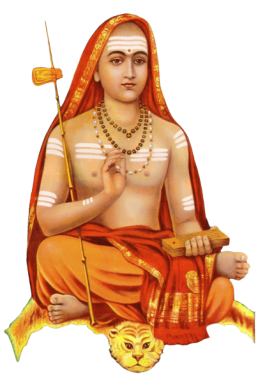न ह्यन्यदस्ति किंचित्सम्यक्परमार्थतत्त्वबोधदशायाम् ॥ २२६ ॥
na hyanyadasti kiṃcitsamyakparamārthatattvabodhadaśāyām || 226 ||
तत्सर्वं ब्रह्मैव प्रत्यस्ताशेषभावनादोषम् ॥ २२७ ॥
tatsarvaṃ brahmaiva pratyastāśeṣabhāvanādoṣam || 227 ||
कुम्भोऽस्ति सर्वत्र तु मृत्स्वरूपात् ।
न कुम्भरूपं पृथगस्ति कुम्भः
कुतो मृषा कल्पितनाममात्रः ॥ २२८ ॥
kumbho’sti sarvatra tu mṛtsvarūpāt |
na kumbharūpaṃ pṛthagasti kumbhaḥ
kuto mṛṣā kalpitanāmamātraḥ || 228 ||
घटस्य संदर्शयितुं न शक्यते ।
अतो घटः कल्पित एव मोहान्
मृदेव सत्यं परमार्थभूतम् ॥ २२९ ॥
ghaṭasya saṃdarśayituṃ na śakyate |
ato ghaṭaḥ kalpita eva mohān
mṛdeva satyaṃ paramārthabhūtam || 229 ||
तन्मात्रमेतन्न ततोऽन्यदस्ति ।
अस्तीति यो वक्ति न तस्य मोहो
विनिर्गतो निद्रितवत्प्रजल्पः ॥ २३0 ॥
tanmātrametanna tato’nyadasti |
astīti yo vakti na tasya moho
vinirgato nidritavatprajalpaḥ || 230 ||
श्रौती ब्रूतेऽथर्वनिष्ठा वरिष्ठा ।
तस्मादेतद्ब्रह्ममात्रं हि विश्वं
नाधिष्ठानाद्भिन्नतारोपितस्य ॥ २३१ ॥
śrautī brūte’tharvaniṣṭhā variṣṭhā |
tasmādetadbrahmamātraṃ hi viśvaṃ
nādhiṣṭhānādbhinnatāropitasya || 231 ||
ऽनन्तत्त्वहानिर्निगमाप्रमाणता ।
असत्यवादित्वमपीशितुः स्यान्
नैतत्त्रयं साधु हितं महात्मनाम् ॥ २३२ ॥
‘nantattvahānirnigamāpramāṇatā |
asatyavāditvamapīśituḥ syān
naitattrayaṃ sādhu hitaṃ mahātmanām || 232 ||
Scriptures……falsified—According to staunch Advaitins the numerous Advaitic texts of the Srutis, inculcating the highest philosophic thought, are alone considered as bearing out the true import of
the Srutis, to which the rest of the Vedas must be subordinated.
The Lord etc.— being the Revealer of the truths of the Srutis. Or the allusion may be to Sri Krishna’s words in the Gita quoted in the next verse.
न च मत्स्थानि भूतानीत्येवमेव व्यचीकॢपत् ॥ २३३ ॥
na ca matsthāni bhūtānītyevameva vyacīkḷpat || 233 ||
यन्नोपलभ्यते किंचिदतोऽसत्स्वप्नवन्मृषा ॥ २३४ ॥
yannopalabhyate kiṃcidato’satsvapnavanmṛṣā || 234 ||
पृथक्प्रतीतिस्तु मृषा गुणादिवत् ।
आरोपितस्यास्ति किमर्थवत्ताद्
धिष्ठानमाभाति तथा भ्रमेण ॥ २३५ ॥
pṛthakpratītistu mṛṣā guṇādivat |
āropitasyāsti kimarthavattād
dhiṣṭhānamābhāti tathā bhrameṇa || 235 ||
It is the substratum —The rope appears as the snake. This idea is made clear in the next few Slokas.
भ्रामैव तत्तद्रजतं हि शुक्तिः ।
इदंतया ब्रह्म सदैव रूप्यते
त्वारोपितं ब्रह्मणि नाममात्रम् ॥ २३६ ॥
bhrāmaiva tattadrajataṃ hi śuktiḥ |
idaṃtayā brahma sadaiva rūpyate
tvāropitaṃ brahmaṇi nāmamātram || 236 ||
Vivekachudamani – Introduction
1: Devoted Dedication
2: Glory of Spiritual Life
3: Unique Graces in Life
4-7: Miseries of The Unspiritual Man
8-13: Means of Wisdom
14-17: The Fit Student
18-30: The Four Qualifications
31: Bhakti – Firm and Deep
32-40: Courtesy of Approach and Questioning
41-47: Loving Advice of the Guru
48-49: Questions of the Disciple
50: Intelligent Disciple – Appreciated
51-55: Glory of Self-Effort
56-61: Knowledge of the Self-Its Beauty
62-66: Direct Experience – Liberation
67-71: Discussion on Questions Raised
72-75: Gross Body
76-82: Sense Objects a Trap – Man Bound
83-86: Fascination for Body Criticised
87-91: Gross Body Condemned
92: Organs of Perception and Action
93-94: Inner Instruments
95: The Five Pranas
96-101: Subtle Body – Effects
102: Functions of Prāna
103-105: Ego Discussed
106-107: Infinite Love – the Self
108-110: Māyā – Pointed Out
111-112: Rajoguņa – Nature and Effects
113-116: Tamoguņa – Nature and Effects
117-119: Sattvaguņa – Nature and Effects
120-121: The Causal Body – Its Nature
122-123: Not-Self – Description
124-135: The Self – Its Nature
136: Advice for Self-control
137-142: What is Bondage – The Reply
143-144: The Powers – Agitation and Veiling
145-146: Bondage in Action
147-153: Ātman and Anātman – Discrimination
Negation of the Kośas
154-164: – Annamaya kośa (Food sheath)
165-166: – Prņamaya kośa (Vital air sheath)
167-183: – Manomaya kosa (Mental sheath)
184-188: – Vijnanamaya kośa (Intellectual sheath)
189-191: Ātman – Unattached
192-193: What is Liberation? – Disciple
194-206: Self-Knowledge gives Liberation
207-210: Anandamaya kośa (Bliss sheath)
211: Ātman – Other than the Five Kośas
212: What is Ātman? – Disciple
213-225: Nature of the Self – Discussion
226-236: All Manifestation Absolute
237-240: Brahman – Its Nature
241-249: That Thou Art – Explanation
250-253: Attitude in Meditation
254-266: Aids to Meditation
267-276: Give up Vāsanās – the Method
277-292: End Superimposition – The Means
293-297: The Perceived I’ Factor – False
298-309: Condemnation of the Ego
310-319: Actions, Thoughts and Vāsanās – Renounce
320-329: Total Vigilance – Its Price
330-338: In the One, No Plurality
339-348: Spiritual Growth – the Secret
349-353: Cause-Effect – False
354-372: Samadhi – Its Nature
373-378: Fully Detached – Samadhi Easy
379-383: Meditation – the Technique
384-397: Continuous Attention to Self
398-406: No Diversity in Reality
407-413: Ātma-vicāra – Contemplation
414-418: Give up Perceptions
419-425: The Science of Reality – Its Benefits
426-445: Signs of a Realised Seer
446-464: Prārabdha for a Saint
465-471: There is No Plurality
472-479: Experience of Selfhood
480-520: Practice of Knowledge – Disciple
521-575: Final Words of Advice
576-578: Blessed Disciple Liberated
579-581: The Glory of the Textbook

Vivekachudamani – Verses 226-236 – Vivekachudamani Verses 226-236 – By Adi Sankaracharya – In Sanskrit with English Meaning, Transliteration, Translation, Commenary, Lyrics, Audio – Vivekachudamani-226-236
